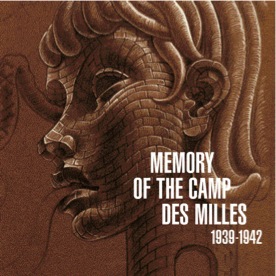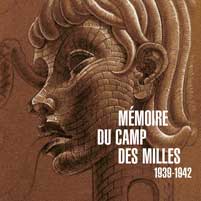

Brick debris and dust lay everywhere, some of it even got into the little we were given to eat. This red dust went right into the pores of our skin. We felt we would ultimately become brick debris ourselves.
Max Ernst
Max Ernst, Écritures, avec cent vingt illustrations extraites de l’œuvre de l’auteur, Gallimard, 1970
We were about a thousand when we arrived. As we marched we raised an enormous cloud of red dust around us – a mixture of brick dust, earth and straw – and the first thing I saw through this red fog when I entered the camp, a little to one side like a ghostly apparition, was the face of Max Ernst.
Ferdinand Springer
Emmanuelle Foster, Ferdinand Springer, Ides et Calendes, 1995
Memory of the Camp des Milles After thirty years of fighting lest the past be forgotten and a vast rehabilitation project, the Camp des Milles Memorial Site opened its gates in 2012 as a major educational and cultural site. As the only French internment and deportation camp still intact, and bearing traces of its past still visible today, the Camp des Milles saw more than 10,000 people of some forty nationalities pass through its portals between 1939 and the end of 1942. This former industrial site is linked to one of the most sombre periods of our history and is a major element of European memory and culture.
Opened in September 1939 under the Third Republic in a tile factory between Aix-en-Provence and Marseille, the Camp des Milles was first of all an internment camp for German and Austrian nationals living in the South of France. A great number of them, including many Jews, were anti-Nazis who had fled the German Reich from 1933 on and many of them were intellectuals, e.g. Lion Feuchtwanger, Walter Hasenclever and Franz Hessel, or artists such as Hans Bellmer, Max Ernst and Ferdinand Springer. By autumn 1940, with the Vichy regime in place, the Camp des Milles became an internment and transit camp for all foreigners, especially a substantial part of the European intelligentsia and former members of the International Spanish Brigades, who were transferred from camps in southwest France. In August-September 1942, as part of the Nazi extermination plan and before the Free Zone was occupied by the Germans, more than 2,000 Jewish men, women and children were deported by the Vichy government from the Camp des Milles in the direction of Auschwitz via Drancy.
In his introduction, Alain Chouraqui, president of the Camp des Milles Foundation – Memory and Education, presents the challenges faced by the Camp des Milles Memorial Site and its missions, which involved working with the younger generation in particular. The historian Robert Mencherini relates the three periods of the camp (internment, transit and deportation) in a summary supported by many archival documents and testimonies from that time. Angelika Gausmann, an art sociologist, analyses the work of artists during the years of internment with reference to their most symbolic works, and the murals in particular. Immersed in the tile factory before its transformation into a memorial, the photographer Yves Jeanmougin captures the spirit of the place and brings back all its evocative strength as an echo to the voices of the internees and deportees, through a substantial portfolio of black and white photographs. The historian Olivier Lalieu, who was responsible for the renovation of the memory sections and the Shoah Memorial, describes the richness of the content and the permanent exhibitions, which are open to the public and shed light on some of the most iconic individual destinies. The Atelier Novembre association, winner of the European contest for best renovation design of the Memorial Site, presents the choices that governed the transformation of this industrial complex into a place of memory, and that were made with a constant concern for the preservation of historic spaces and the many traces left by the internees (such as decorations, drawings and written works), which were restored following patient heritage research work.
Read an excerpt from the text by Robert Mencherini.
Read an excerpt from the text by Angelika Gausmann.
Read an excerpt from the text by Olivier Lalieu.
Read an excerpt from the text by Atelier Novembre.

Cover
illustration: Hans Bellmer
For a preview of the book (Flash
sequence)
click on the cover.
Memory
of the Camp des Milles 1939-1942
Photographs
Yves
Jeanmougin
Texts
Robert
Mencherini
Angelika Gausmann
Olivier Lalieu
Atelier Novembre
Preface by Alain
Chouraqui
Photos published in this book were taken between 2008 and
2012.
Hardcover book / 27 x 27 cm in size / 240 pages /
360 illustrations in both b & w and colour
Métamorphoses / Le Bec en l’air (2013)
ISBN 978-2-916073-97-2
29
€
Also available in French:
Mémoire du camp des Milles
1939-1942
Edition produced in
partnership with:

and with the help of:

This book is available at the Camp des Milles Memorial
Site,
in bookshops or directly from:
Métamorphoses
Friche la Belle de Mai 41 rue
Jobin 13003 Marseille / France

Download the
order form
meta@metamorphoses-arts.com
Initiated by photographer Yves
Jeanmougin and produced by Métamorphoses, this
Memory of the Camp des
Milles publication
has been created in partnership with the Camp des Milles
Foundation – Memory and Education, with the help of the
Shoah Memorial, and support from the Conseil régional de
Provence-Alpes-Côte d’Azur, the Conseil général des
Bouches-du-Rhône, the Ville de Marseille and the Friche la
Belle de Mai.
This edition has also benefited from the invaluable
participation of the Archives départementales des
Bouches-du-Rhône, the United States Holocaust Memorial
Museum, the Association philatélique du pays d'Aix, as well
as many families of internees and deportees, and private
collectors.

